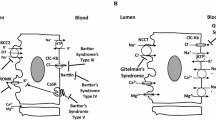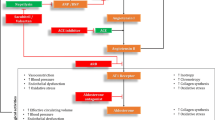Abstract
Introduction
Extensive studies using Bartter’s/Gitelman’s syndrome patients have provided insights into the angiotensin II (Ang II) signaling pathways involved in the regulation of vascular tone and cardiovascular–renal remodeling. The renin–angiotensin–aldosterone system is activated in these syndromes, however, patients do not develop hypertension and cardiovascular remodeling and clinically manifest conditions opposite to hypertension. The short- and the long-term signaling of Ang II remains an important matter of investigation to shed light on mechanisms responsible for the pathophysiology of hypertension and its long-term complications. The long-term signaling of Ang II is involved in the pathophysiology of cardiovascular–renal remodeling and inflammatory responses in which the balance between RhoA/Rho kinase pathway and NO system plays a crucial role.
Methods and results
In this brief review, the results of our studies in Bartter’s and Gitelman’s syndromes are reported on these processes.
Conclusions
The information obtained from these studies can clarify, confirm or be used to extend the biochemical mechanisms responsible for the pathophysiology of hypertension and its long-term complications and could offer further chances to identify additional potential significant targets of therapy.

Similar content being viewed by others
References
Benigni A, Corna D, Zoja C, Sonzogni A, Latini R, Salio M, Conti S, Rottoli D, Longaretti L, Cassis P, Morigi M, Coffman TM, Remuzzi G (2009) Disruption of the Ang II type 1 receptor promotes longevity in mice. J Clin Invest 119:524–530
Naesens M, Steels P, Verberckmoes R, Vanrenterghem Y, Kuypers D (2004) Bartter’s and Gitelman’s syndromes: from gene to clinic. Nephron Physiol 96:65–78
Calò L, D’Angelo A, Cantaro S, Rizzolo M, Favaro S, Antonello A, Borsatti A (1996) Intracellular calcium signalling and vascular reactivity in Bartter’s syndrome. Nephron 72:570–573
Calò LA, Schiavo S, Davis PA, Pagnin E, Mormino P, D’Angelo A, Pessina AC (2010) Angiotensin II signaling via type 2 receptors in a human model of vascular hyporeactivity: implications for hypertension. J Hypertens 28:111–118
Calò LA (2006) Vascular tone control in humans: insights from studies in Bartter’s/Gitelman’s syndromes. Kidney Int 69:963–966
Calò LA, Davis PA, Rossi GP (2014) Understanding the mechanisms of angiotensin II signaling involved in hypertension and its long-term sequelae: insights from Bartter’s and Gitelman’s syndromes, human models of endogenous angiotensin II signaling antagonism. J Hypertens 32:2109–2119
Calò LA, Ceolotto G, Milani M, Pagnin E, van den Heuvel LP, Sartori M, Davis PA, Costa R, Semplicini A (2001) Abnormalities of Gq-mediated cell signaling in Bartter and Gitelman syndromes. Kidney Int 60:882–889
Calò LA, Pagnin E, Davis PA, Sartori M, Ceolotto G, Pessina AC, Semplicini A (2004) Increased expression of regulator of G protein signaling-2 (RGS-2) in Bartter’s/Gitelman’s syndrome. A role in the control of vascular tone and implication for hypertension. J Clin Endocrinol Metab 89:4153–4157
Calò LA, Pagnin E, Ceolotto G, Davis PA, Schiavo S, Papparella I, Semplicini A, Pessina AC (2008) Silencing regulator of G protein signaling-2 (RGS-2) increases angiotensin II signaling: insights into hypertension from findings in Bartter’s/Gitelman’s syndromes. J Hypertens 26:938–945
Di Virgilio F, Calò L, Cantaro S, Favaro S, Piccoli A, Borsatti A (1987) Resting and stimulated cytosolic free calcium levels in neutrophils from patients with Bartter’s syndrome. Clin Sci 72:483–488
Calò L, D’Angelo A, Cantaro S, Rizzolo M, Favaro S, Antonello A, Borsatti A (1996) Intracellular calcium signalling and vascular reactivity in Bartter’s syndrome. Nephron 72:570–573
Mehta PK, Griendling KK (2007) Angiotensin II cell signaling. Physiological and pathological effects in the cardiovascular system. Am J Physiol Cell Physiol 92:C82–C97
Griendling KK, FitzGerald GA (2003) Oxidative stress and cardiovascular injury: part II: animal and human studies. Circulation 108:2034–2040
Calò LA, Pagnin E, Davis PA, Sartori M, Semplicini A (2003) Oxidative stress related factors in Bartter’s and Gitelman’s sindrome: relevance for angiotensin II signaling. Nephrol Dial Transplant 18:1518–1525
Calò LA, Facco M, Davis PA, Pagnin E, Maso LD, Puato M, Caielli P, Agostini C, Pessina AC (2011) Endothelial progenitor cells relationships with clinical and biochemical factors in a human model of blunted angiotensin II signaling. Hypertens Res 34:1017–1022
Calò LA, Sartore G, Bassi A, Basso C, Bertocco S, Marin R, Zambon S, Cantaro S, D’Angelo A, Davis PA, Manzato E, Crepaldi G (1998) Reduced susceptibility of low density lipoprotein to oxidation in patients with overproduction of nitric oxide (Bartter’s and Gitelman’s sindrome). J Hypertens 16:1001–1008
Calò L, Davis PA, Milani M, Cantaro S, Antonello A, Favaro S, D’Angelo A (1999) Increased endothelial nitric oxide synthase mRNA level in Bartter’s and Gitelman’s syndrome. Relationship to vascular reactivity. Clin Nephrol 51:12–17
Calò L, D’Angelo A, Cantaro S, Bordin MC, Favaro S, Antonello A, Borsatti A (1996) Increased urinary NO2-/NO3- and cyclic GMP levels in patients with Bartter’s syndrome: relationship to vascular reactivity. Am J Kidney Dis 27:874–879
Calò LA, Puato M, Schiavo S, Zanardo M, Tirrito C, Pagnin E, Balbi G, Davis PA, Palatini P, Pauletto P (2008) Absence of vascular remodelling in a high angiotensin-II state (Bartter’s and Gitelman’s syndromes): implications for angiotensin II signalling pathways. Nephrol Dial Transplant 23:2804–2809
Pagnin E, Davis PA, Sartori M, Semplicini A, Pessina AC, Calò LA (2004) Rho kinase and PAI-1 in Bartter’s/Gitelman’s syndromes: relationship to angiotensin II signaling. J Hypertens 22:1963–1969
Calò LA, Pessina AC (2007) RhoA/Rho-kinase pathway: much more than just a modulation of vascular tone. Evidence from studies in humans. J Hypertens 25:259–264
Loirand G, Guerin P, Pacaud P (2006) Rho kinases in cardiovascular physiology and pathophysiology. Circ Res 98:322–324
Sauzeau V, Rolli-Derkinderen M, Marionneau C, Loirand G, Pacaud P (2003) RhoA expression is controlled by nitric oxide through cGMP-dependent protein kinase activation. J Biol Chem 278:9472–9480
Jin HG, Yamashita H, Nagano Y, Fukuba H, Hiji M, Ohtsuki T, Takahashi T, Kohriyama T, Kaibuchi K, Matsumoto M (2006) Hypoxia-induced upregulation of endothelial small G protein RhoA and Rho-kinase/ROCK2 inhibits eNOS expression. Neurosci Lett 408:62–67
Higashi M, Shimokawa H, Hattori T, Hiroki J, Mukai Y, Morikawa K, Ichiki T, Takahashi S, Takeshita A (2003) Long-term inhibition of Rho-kinase suppresses angiotensin II-induced cardiovascular hypertrophy in rats in vivo. Effect on endothelial NAD(P)H oxidase system. Circ Res 93:767–775
Kataoka C, Egashira K, Inoue S, Takemoto M, Ni W, Koyanagi M, Kitamoto S, Usui M, Kaibuchi K, Shimokawa H, Takeshita A (2002) Important role of Rho-kinase in the pathogenesis of cardiovascular inflammation and remodeling induced by long-term blockade of nitric oxide synthesis in rats. Hypertension 39:245–250
Pagnin E, Davis PA, Semplicini A, Calò LA (2006) The search for a link between inflammation and hypertension—contribution from Bartter’s/Gitelman’s syndromes. Nephrol Dial Transplant 21:2340–2342
Sowers JR (2004) Insulin resistance and hypertension. Am J Physiol Heart Circ Physiol 286:H1597–H1602
Nakakuki T, Ito M, Iwasaki H, Kureishi Y, Okamoto R, Moriki N, Kongo M, Kato S, Yamada N, Isaka N, Nakano T (2005) Rho/Rho-kinase pathway contributes to C-reactive protein-induced plasminogen activator inhibitor-1 expression in endothelial cells. Arterioscler Thromb Vasc Biol 25:2088–2093
Wolfrum S, Dendorfer A, Rikitake Y, Stalker TJ, Gong Y, Scalia R, Dominiak P, Liao JK (2004) Inhibition of Rhokinase leads to rapid activation of phosphatidylinositol 3 kinase/protein kinase Akt and cardiovascular protection. Arterioscler Thromb Vasc Biol 24:1842–1847
Wennerberg K, Der CJ (2004) Rho-family GTPases: it’s not only Rac and Rho (and I like it). J Cell Sci 117:1301–1312
Siderovski DP, Willard FS (2005) The GAPs, GEFs, and GDIs of heterotrimeric G-protein alpha subunits. Int J Biol Sci 1:51–66
Ying Z, Jin L, Dorrance AM, Webb RC (2004) Increased expression of mRNA for regulator of G protein signaling domain-containing Rho guanine nucleotide exchange factors in aorta from stroke-prone spontaneously hypertensive rats. Am J Hypertens 17:981–985
Wuertz MC, Lorincz A, Vettel C, Thomas MA, Wieland T, Lutz S (2010) p63RhoGEF—a key mediator of angiotensin II dependent signaling and processes in vascular smooth muscle cells. FASEB J 24:4865–4876
Momotani K, Artamonov MV, Utepbergenov D, Derewenda U, Derewenda ZS, Somlyo AV (2011) p63RhoGEF couples Gaq/11-mediated signaling to Ca2+sensitization of vascular smooth muscle contractility. Circ Res 109:993–1002
Guilluy C, Brégeon J, Toumaniantz G, Rolli-Derkinderen M, Retailleau K, Loufrani L, Henrion D, Scalbert E, Bril A, Torres RM, Offermanns S, Pacaud P, Loirand G (2010) The Rho exchange factor Arhgef1 mediates the effects of angiotensin II on vascular tone and blood pressure. Nat Med 16:183–190
Calò LA, Davis PA, Pagnin E, Dal Maso L, Maiolino G, Seccia TM, Pessina AC, Rossi GP (2014) Increased level of p63RhoGEF and RhoA/Rho kinase activity in hypertensive patients. Implications for vascular tone regulation and cardiovascular remodeling. J Hypertens 32:331–338
Calò LA, Pagnin E, Davis PA, Sartori M, Semplicini A, Pessina AC (2005) Rho kinase inhibition and vascular protection: support from studies in Bartter and Gitelman syndrome. Arterioscler Thromb Vasc Biol 25:34–35
Pagnin E, Semplicini A, Sartori M, Pessina AC, Calò LA (2005) Reduced mRNA and protein content of Rho guanine nucleotide exchange factor (RhoGEF) in Bartter’s and Gitelman’s syndromes: relevance for the pathophysiology of hypertension. Am J Hypertens 18:1200–1205
Wirth A (2010) Rho kinase and hypertension. Biochim Biophys Acta 1802:1276–1284
Savoia C, Tabet F, Yao G, Schiffrin EL, Touyz RM (2005) Negative regulation of RhoA/Rho kinase by angiotensin II type 2 receptor in vascular smooth muscle cells: role in angiotensin II-induced vasodilation in stroke-prone spontaneously hypertensive rats. J Hypertens 23:1037–1045
Calò LA, Montisci R, Scognamiglio R, Davis PA, Pagnin E, Schiavo S, Mormino P, Semplicini A, Palatini P, D’Angelo A, Pessina AC (2009) High angiotensin II state without cardiac remodeling (Bartter’s and Gitelman’s syndromes). Are angiotensin II type 2 receptors involved? J Endocrinol Invest 32:832–836
Carey RM (2005) Cardiovascular and renal regulation by the angiotensin type 2 receptor: the AT2 receptor comes of age. Hypertension 45:840–844
Davis PA, Mussap M, Pagnin E, Bertipaglia L, Savica V, Semplicini A, Calò LA (2006) Early markers of inflammation in a high angiotensin II state. Results of studies in Bartter’s/Gitelman’s syndromes. Nephrol Dial Transplant 21:1697–1701
Ruiz-Ortega M, Ruperez M, Lorenzo O, Esteban V, Blanco J, Mezzano S, Egido J (2002) Angiotensin II regulates the synthesis of proinflammatory cytokines and chemokines in the kidney. Kidney Int 62(Suppl. 82):12–22
Cheng ZJ, Vapaatalo H, Mervaala E (2005) Angiotensin II and vascular inflammation. Med Sci Monit 11:RA194–RA205
Das UN (2005) Is angiotensin II an endogenous pro-inflammatory molecule? Med Sci Monit 11:155–162
Nakakuki T, Ito M, Iwasaki H, Kureishi Y, Okamoto R, Moriki N, Kongo M, Kato S, Yamada N, Isaka N, Nakano T (2005) Rho/Rho-kinase pathway contributes to C-reactive protein-induced plasminogen activator inhibitor-1 expression in endothelial cells. Arterioscler Thromb Vasc Biol 25:2088–2093
Segain JP, Raingeard de la Bletiere D, Sauzeau V, Bourreille A, Hilaret G, Cario-Toumaniantz C, Pacaud P, Galmiche JP, Loirand G (2003) Rho kinase blockade prevents inflammation via nuclear factor kappa B inhibition: evidence in Crohn’s disease and experimental colitis. Gastroenterology 124:1180–1187
Calò LA, Davis PA, Pagnin E, Schiavo S, Semplicini A, Pessina AC (2008) Linking inflammation and hypertension in humans: studies in Bartter’s/Gitelman’s syndromes. J Hum Hypertens 22:223–225
Shi J, Wei L (2013) Rho kinases in cardiovascular physiology and pathophysiology: the effect of fasudil. J Cardiovasc Pharmacol 62:341–354
Conflict of interest
The authors have no conflict of interest.
Ethical approval
This article does not contain any studies with human participants or animals performed by any of the authors.
Informed consent
No informed consent.
Author information
Authors and Affiliations
Corresponding author
Rights and permissions
About this article
Cite this article
Calò, L.A., Maiolino, G. Mechanistic approach to the pathophysiology of target organ damage in hypertension from studies in a human model with characteristics opposite to hypertension: Bartter’s and Gitelman’s syndromes. J Endocrinol Invest 38, 711–716 (2015). https://doi.org/10.1007/s40618-015-0249-z
Received:
Accepted:
Published:
Issue Date:
DOI: https://doi.org/10.1007/s40618-015-0249-z




